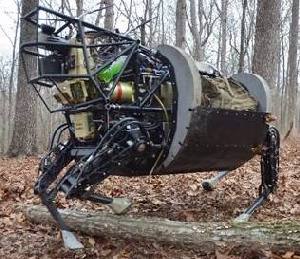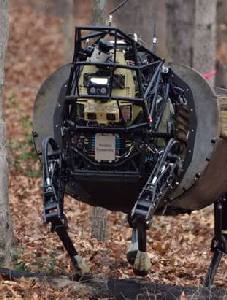| Designation: | LS3 |
 |
|---|---|---|
| Manufacturer: | Boston Dynamics | |
| Product type: | Auxiliary Vehicles | |
| Name: | Robot, Unmanned Vehicle |
LS3 is a four-legged, all-terrain robot developed by Boston Dynamics with funding from DARPA and the US Marine Corps. It is designed to carry equipment and supplies for dismounted soldiers and Marines. It is essentially a robotic pack mule. The highly mobile LS3 can go where wheeled or tracked vehicles cannot: steep and narrow footpaths, forests, and other places that can only be traversed on foot.
NREC’s rugged, lightweight sensor head enables LS3 to follow a human leader while avoiding trees, bushes, boulders, walls, and other obstacles. It uses software developed jointly by NREC and NASA’s Jet Propulsion Laboratory.
LS3 is jointly sponsored by the DARPA Tactical Technology Office (TTO) and the Marine Corps Warfighting Laboratory (MCWL). Boston Dynamics is the prime contractor; NREC and NASA’s Jet Propulsion Laboratory (JPL) are subcontractors.
Dismounted soldiers and Marines may have to carry 100 pounds of gear or more in the field. Hauling around this heavy load is exhausting, causes injuries, and slows them down – limiting how well they can perform their missions.
To lighten the load, Boston Dynamics is developing a rugged, highly mobile, four-legged robot, the Legged Squad Support System (LS3). LS3 walks (or even runs) with dismounted troops, lugging along their gear and supplies. It carries 400 pound loads and has enough fuel on board to travel up to 20 miles on missions that can last as long as 24 hours.
LS3 follows troops, navigates through its surroundings, and obeys commands in a way that’s similar to a trained pack animal. To do these things, it must be able to perceive the world around it and act on that information. LS3’s perception system gives it the ability to sense and understand its environment.
LS3’s perception system includes stereo, color, and infrared cameras plus ladar. It uses these sensors to locate and classify obstacles, generate 3D maps of terrain, and follow personnel. LS3 can detect and avoid obstacles in its path. It is able to distinguish vegetation (which it can pass through) from rocks and other hard obstacles (which it cannot).
The perception system is designed to operate at LS3’s walking speed, approximately 3 mph. LS3’s Pose estimation, developed by NASA’s Jet Propulsion Laboratory, fuses sensed terrain into persistent terrain maps. The perception system will also support LS3’s natural user interface.
LS3 can track and follow an individual soldier or Marine in several different ways.
In leader-follower tight mode, LS3 tracks and follows the leader’s path as closely as possible. It trusts the leader to choose a safe route that avoids dangerous obstacles and terrain.
In leader-follower corridor mode, LS3 tracks and follows the leader but is free to choose its own path that avoids obstacles and terrain hazards. The leader does not need to worry about picking a route that is safe for the robot.
In go-to-waypoint mode, LS3 navigates on its own to a specific location. It uses its perception system to find a route to its goal, avoiding obstacles and terrain hazards along the way.
Troops can also directly operate LS3 with a hand-held controller.
|
||||||||||
Related Articles |
|
Robot to Serve as Future Military’s ‘Pack Mule’ (20.12.2012) |
|
DARPA’s Four-Legged Robots Walk Out for Capabilities Demonstration (12.09.2012) |
|
DARPA’S LS3 AlphaDog begins outdoor testing (10.02.2012) |
|
DARPA readies Big Dog for the battlefield (22.05.2010) |
 |
 |
